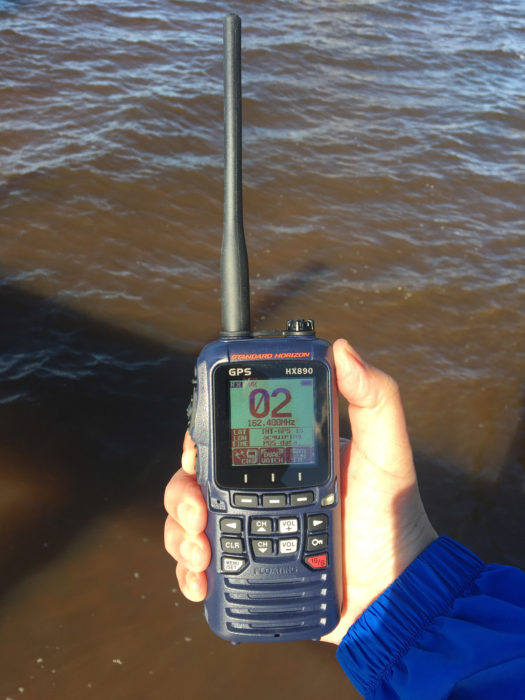 Photographs by the authors
Photographs by the authorsThe HX890 packs VHF, GPS, FM radio, distress beacon, and many other features in a waterproof unit that will fit in a PFD pocket.
Audrey and I wanted to buy a full-featured handheld VHF transceiver for communication, navigation, and emergency response; our research led us to the Standard Horizon HX890 with DSC and GPS.
The HX890 floats and is submersible down to 1-1/2 meters for 30 minutes, important features for boating kit. It functions as a standard VHF marine-band two-way radio and can transmit digital distress calls that include latitude and longitude provided by its 66-channel GPS receiver as well as a Maritime Mobile Service Identity (MMSI) number, a unique nine-digit number that is assigned to Digital Selective Calling (DSC) transceivers. We obtained our number through BoatUS; it provides our names, address, emergency contacts, and information about our boat. The MMSI number is entered into the HX890 during its initial setup.
This DSC transceiver enables boaters to make digital calls to other boaters. It can send out a preprogrammed message to any listener on a selected frequency or transmit a private alert to initiate a voice call. DSC improves upon analog voice calls by reducing frequency congestion, transmitting preprogrammed digital messages out to a slightly longer range, and helping ensure that critical calls are received by rescue agencies. Up to 100 DSC contacts can be stored, and combined in up to 20 groups. The HX890 can receive a DSC distress alert and be directed by a directional compass to the aid of a boater in distress.
As a GPS unit, the HX890 can be used for navigation. It can store up to 250 waypoints and multiple routes. It can be used to navigate to a GPS position received from another DSC radio. A man-overboard (MOB) function records the position of a person who has fallen overboard and points the way back that spot. The HX890 can be set up to automatically turn on and activate an LED light when it senses water immersion if the user goes overboard.
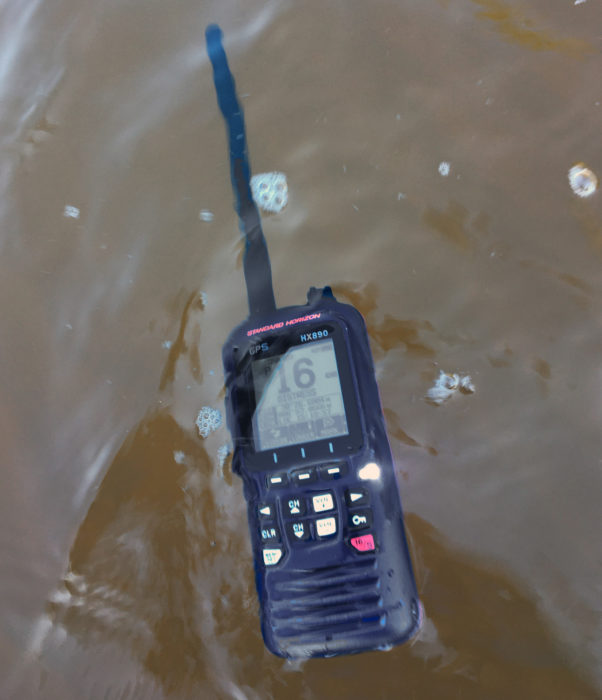
Dropped into the water, the HX890 floats face up and activates its built-in light, the bright spot here in the middle of its right side.
Another feature of the HX890 is Group Monitoring (GM), where group members’ locations can be displayed. Ten groups of one to nine members can be stored. Individual locations will be displayed, calls to members can be transmitted and the transceiver can be used to navigate to them. Communications between other DSC users can be scrambled to be private. The HX890 can receive FM radio and get updated weather through the NOAA radio frequencies.
The HX890 transceiver comes with a manual, rechargeable lithium-ion battery that provides 11 hours of operating time, charging cradle, AC adapter, DC cable with 12-volt-lighter plug, a case for using five AAA alkaline batteries, belt clip, hand strap, and USB cable. The device is compact, measuring 2.60″ x 5.43″ x 1.50″ not including antenna, and lightweight, weighing just 10.94 oz. The backlit display screen measures 2.3″ diagonally and has adjustable brightness for day/night operations. The LED strobe light can be programmed to burn steady, flash at three different rates, or flash distress SOS. The strobe is at the upper right of the control buttons, so facing the operator, but it is not a powerful light. A lot of SAR agencies have night-vision devices so a little goes a long way. You can set the light to go on when the VHF is submerged; the radio turns face up when dropped in the water, so having the light go on will help you to locate it in the dark.
The controls are intuitive, with a dedicated Channel 16/Sub Frequency button and a soft-key-driven menu system—the soft keys are programmable to allow personal choices of 16 different functions, such as weather radio, transmit power, scan, compass, and position logging. The transceiver can be set up to scan multiple desired frequencies or to stand watch over two to three priority frequencies. The HX890 has a very powerful 6-watt transmitter, adjustable down to 2W or 1W, with a line-of-sight range of over 5 miles.
Should one purchase the HX890E for international use, it will also support the Automatic Transmitter Identification System (ATIS) used in inland waterways of Europe. Whether it be for the basic or advanced features, we consider the HX890 to be a great value.![]()
Kent and Audrey Lewis mess about in a small armada of boats in the waterways of northwest Florida. You can follow them on their adventure blog.
The HX890 is manufactured by Standard Horizon and available for around $199.99 from many marine supply stores and online retailers.
Is there a product that might be useful for boatbuilding, cruising, or shore-side camping that you’d like us to review? Please email your suggestions.
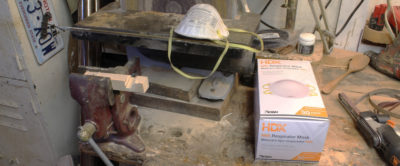
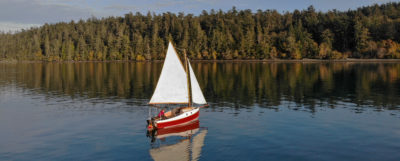

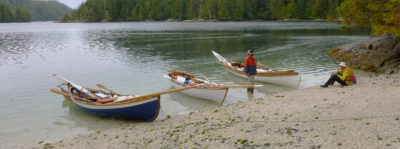

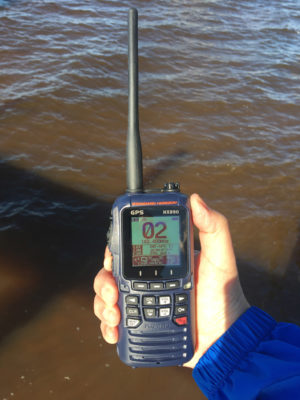
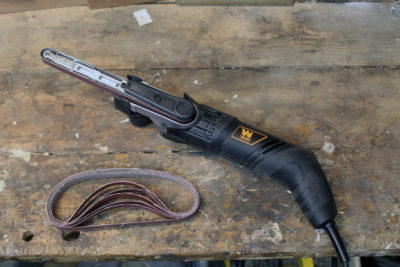

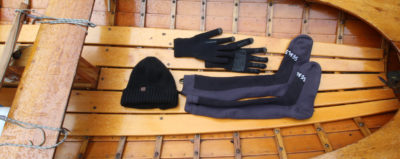

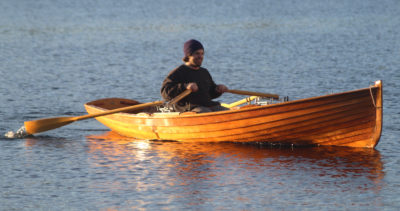
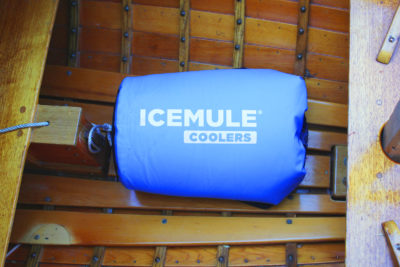
This is clearly a terrific device. Thanks for the review.
In my perhaps over-cautious “belt-and-suspenders” manner, I own two handheld VHFs. The older one is simpler. The newer on is essentially identical to the HX890 above. These newer VHFs are great with all their features. The ability to have a distress button which sends a clear message with position is a true safety advance.
I think there are minor drawbacks. There are so many features its hard for me to remember (or even understand) how to use them. I note that my older models battery lasts longer. This makes sense…unless I am transmitting, it mostly sits and monitors channel 16.
I sometimes sail on a friend’s boat. I believe that I am forbidden from using my new VHFs digital distress message because the MMSI number is tagged to a particular vessel. For now I use my old VHF as my working unit and keep my new VHF as the backup.
“There are so many features its hard for me to remember (or even understand) how to use them. ”
This is a dealbreaker for me.
I have an older hand-held VHF device without DSC. I have been considering an upgrade and a GPS. The unit reviewed would fill both wants. I also thank Francis for pointing out some other considerations. I would add that I have had the radio for a number of years, assuming that my radio instruction and license from 30 years ago made operation of my unit legal. I took the Canadian Power Squadron radio course last fall. I got my new permanent license. I learned not only how to better use my equipment, but that I had been using it illegally.
I have the HX890 and the HX880 in addition to several others used as backup, ditch bag, dinghy, and personal emergency radios on an Oyster 53. My thoughts echo those of Francis K in that the unit has so many features and such a complex display that it may be best suited as a primary VHF rather than a backup. Ditch bag/life raft use would be good assuming you aren’t in a rush or panic (sure) remember how to use it and can read it (reading glasses?) given it’s GPS & DSC features. Another point to note, once the MMSI is entered you cannot change it without sending it to a factory to be reset. Good luck with that. Not sure other radios are different but be forewarned.
An MMSI number shouldn’t be used in a portable Type H radio. Use an MI number which registers the unit to a person not a vessel. Then it can be DSC activated for a Mayday and the information of the owner comes up, not a vessel. Also, register your MMSI or MI with the FCC. The other providers are good for use in US waters but if you come into Canada, for example, you need an internationally recognized number. On the coasts or the Great Lakes this is important. You will also need a station license for the fixed radio on the boat outside the US, or Canada if a Canadian vessel and a ROC(M) for the operator.
I used one of these for a kayaking trip in Alaska back in ‘18. Something was happening while it was clipped to my PFD that caused the battery life to drain rapidly. My partner had the same radio, but she didn’t have any problems. I can’t remember what the exact problem was, just that I was often left with dead batteries after 4 hours, I returned it when I got back; maybe I just had a bum radio…